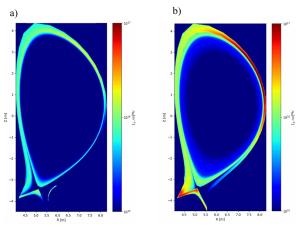Favourable impurity dynamics in ITER confirmed by experiment
Recent studies at the JET tokamak confirm the physics basis for tungsten transport at the edge of fusion-producing plasmas in ITER and the project's strategy for tungsten impurity control.
To achieve effective fusion power production in ITER's plasmas it is very important to keep the plasmas clean from impurities. "Impurities" is the term used to name atoms from the wall of fusion devices that enter the plasma. Their presence dilutes the fusion fuels deuterium and tritium and also cools the plasma due to the emission of radiation (visible, ultraviolet and X-ray light). Both factors reduce fusion power production—and thus the proportion of impurities in the plasma needs to be kept at very low values. This is especially the case for tungsten (W) which is the material used for the areas of the wall receiving the largest power fluxes in ITER (the divertor). The amount of tungsten in an ITER high-fusion-gain plasma has to be kept under ~ 0.005 percent.
Detailed studies to simulate how the tungsten atoms eroded from ITER's walls penetrate in the fusion plasma were carried out about one decade ago. These studies used the same models that can reproduce tungsten behaviour in currently operating tokamaks but, for the first time, applied to ITER in systematic way. The results obtained at that time were surprising: ITER edge plasma characteristics are very effective in screening the fusion plasma from the tungsten atoms coming from the wall (Figure a, above)—a behaviour never seen before.
Because these predictions were done on a solid physics basis, this favourable tungsten behaviour was included in the planning of the ITER scientific program (see the ITER Research Plan here); the experimental demonstration of this behaviour, however, remained outstanding. Further analysis of the physics involved in the original studies showed that this ITER-specific behaviour also had one less-desirable consequence—edge instabilities called ELMs would actually bring impurities into the plasma (Figure b, above). This is unlike in currently operating tokamaks, where such instabilities are employed to expel impurities from the plasma.
For ITER, this meant reformulating the ELM control strategy that had originally been considered. The new strategy relies on the suppression of these edge instabilities as soon as possible in the execution of the ITER Research Plan, and in particular before high power, requiring radiative divertor operation, is applied. This strategy would allow ITER to benefit from the enhanced screening of tungsten predicted by physics, while avoiding the drawbacks of ELMs in such plasma conditions.
Despite the importance of this plasma physics behaviour for ITER scenario development and for the achievement of high-fusion performance with low tungsten concentration in the plasma, an experimental demonstration had never been achieved. That has now changed. As reported in a paper* published in December in Nuclear Fusion, JET scientists were recently able to reproduce this ITER-like tungsten behaviour. The demonstration relied on the achievement of peripheral plasma parameters in JET that are comparable to those in ITER, and on the development of complex analysis tools to determine tungsten behaviour from the acquired measurements in a quantitative way, as described in the publication. These experimental findings provide key confirmation of the physics basis for tungsten transport at the edge of fusion-producing plasmas in ITER and of the strategy for tungsten impurity control adopted in the ITER Research Plan.
See a related article on the EUROfusion website.
*A.R. Field et al 2023 Nucl. Fusion 63 016028


